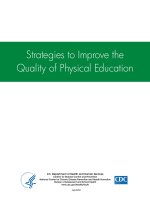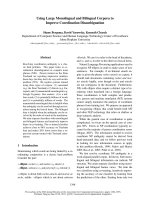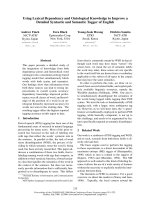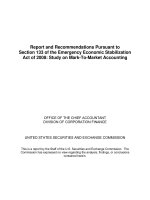Management and supplementation strategies to improve reproduction of beef cattle on fescue
Bạn đang xem bản rút gọn của tài liệu. Xem và tải ngay bản đầy đủ của tài liệu tại đây (3.76 MB, 30 trang )
Management and
Supplementation Strategies
to Improve Reproduction of
Beef Cattle on Fescue
John B. Hall
Extension Beef Specialist
Virginia Tech
Effects of Endophyte Infected
Fescue on Reproduction in Cattle
Decreased pregnancy rates
• Cleavage failure
• Compromised sperm physiology
• Early embryonic mortality
• Reduced follicular growth
• Decreased progesterone production
Reduced or limited milk production
Strategies to Combat Effects of
Fescue
Supplementing Nutrients
•
•
•
Energy
Protein
Minerals
Mitigating Effects of Toxins
•
•
Blocking physiological actions
Changing calving seasons
Reducing Exposure
•
•
•
Grazing other forages
Dilution of fescue with other forages or feeds
Feeding adsorbents or detoxifying agents
Supplementing nutrients
Consumption of E+ fescue decreases forage intake
Energy is the limiting nutrient, but protein may also be needed
Exacerbated by high environmental temperatures
Supplementing nutrients
By-pass protein may or may
not increase cow
performance
Effective level of by-pass
protein depended on source
of energy - corn vs soyhulls
(MO)
By-pass protein did not affect
performance (U of IL)
Effect of Supplement Type on
Heifer Pregnancy Rate
Heifers developed on
E+ fescue
Received 1.0% of
BW in supplement
Equal amounts of
protein and energy
Gained 1.5 to 1.7
lbs/day
Impact of High Fat Supplementation
on Pregnancy Rates of Cows
Grazing E+ Fescue
Mineral Supplementation
Mineral requirements of cattle are dependent on physiological status
• Lactating vs. dry
• Growing vs. mature
Mineral content of forage is dependent on:
• Soil fertility
• Forage type and maturity
Mineral Supplementation
Animals consuming fescue
• Have decreased immune function
• May have impaired absorption of phosphorus
There appears to be no magic fescue mineral but…
• Increasing levels of trace minerals related to
•
immune function may be beneficial
Mineral intake needs to be monitored closely
Minerals supplement Commercial
Mineral Supplements Commercial
Pregnancy Rates in Spring or
Fall Calving VA DOC Herds
Comparison of Pregnancy Rates in
Spring and Fall Calving Herds –
Fall Line Operation
y
c
n
a
n
g
e
pr
r
e
!
s
w
e
o
l
lv
a
%
c
5
.7
87
8
r
n
e
a
v
o
d
a
s
h 633 /h668
t’
a
861 / 1001
g
n
i
T
r
.
e
Sp
t
a
r
Stockpiled Fescue
Graze off field
60 units of N - Aug.
Don’t graze ‘til after frost
Grazing from Nov-Feb
High quality -
•
•
60+ % TDN
10 - 12 % CP
Low Cost - High Value
Use strip grazing
Utilizing Stockpiled Forage
Always utilize grass-legume mixture first
Strip graze
• maximizes utilization
• only enough forage for 7-14 d
• no back fence needed
vs
Cattle selection for fescue
Using a “fescue tolerant” bull did not affect performance of calves (VPI&SU)
Brahman and Brahman X cattle had increased milk production and weaning weights on fescue than Angus
(UARK)
Impacts of selection
There are tolerant cattle – eliminate fescue queens
Care in selecting bulls from non-fescue regions
Breed used must not only perform on fescue, but needs to perform in feedlot and meet regional market
Impact of TASCO mineral on Pregnancy
Rates in Cows Grazing E+ Fescue









